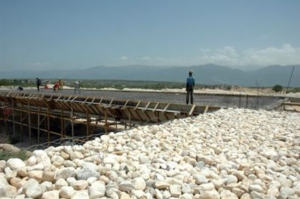 Dominican Today.com: Dajabón, Dominican Republic.- Ramon Garcia, a farmer whose rice field of a bit more than four hectares in the community La Vigia, is close to disappearing , fixed his gaze on the rerouting humans caused to the Masacre river’s natural course, which doesn’t let the water reach the channel which months ago normally irrigated his land, the only source of livelihood for his family of five.
Dominican Today.com: Dajabón, Dominican Republic.- Ramon Garcia, a farmer whose rice field of a bit more than four hectares in the community La Vigia, is close to disappearing , fixed his gaze on the rerouting humans caused to the Masacre river’s natural course, which doesn’t let the water reach the channel which months ago normally irrigated his land, the only source of livelihood for his family of five.
Eldia.com.do reports that a visibly worried Garcia asked two Army soldiers guarding the river’s eastern bank which marks the Dominican -Haiti border, “What are you going to do?”
The farmer was referring to the problem of the extraction of aggregates for construction on the Haitian side. The soldiers didn’t respond because they’re helpless since the problem under the jurisdiction of Haiti’s authorities.
Before the eyes of Dajabon’s authorities and the people, dozens of Haitians from Ouanaminthe and other Haitian towns see extraction of sand and gravel from the river daily, loading the aggregates onto trucks
A dump truck load of materials which costs as much as RD$2,000 on the Dominican side, on the other side of the border, just a few meters away, it costs only RD$250.
The practice has become more evident as Haiti’s north, including Cap Haitien, demands a quickened pace for construction, stemming from the displacement of most of people after the quake that leveled Port-au-Prince in January 2010.
Extraction impact
Aggregate extraction on the Haitian side of the Masacre has begun to impact negatively on the country, not only farmers, but also threatens trade and vehicle traffic, since the bridge between the two countries could collapse.
The ground has eroded to the point that it has already damaged the columns of the bridge on which thousands of Dominicans and Haitians cross daily, in vehicles and walking, including undocumented immigrants.
“The greatest danger of this is that the unacceptable predation is pushing the formation of meanders on the river, which will result in disproportionate swells during the rainy season,” says the biologist and environmentalist Domingo Contreras.
The professional’s concern is over the changes in the river’s course. In that regard, the also Presidency’s adviser on Municipal Affairs warns that if the situation continues, “Dajabón, surrounding communities and the Haitian populations will be impacted at any time by major flooding when swellings occur on the Masacre.”